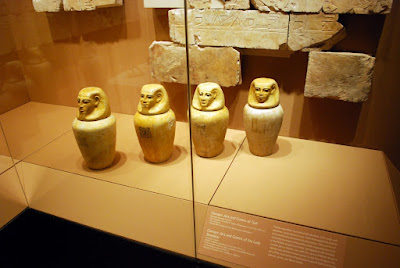The Brooklyn Museum's collection of ancient Egyptian art, one of the largest and finest in the United States, is renowned throughout the world. The Egyptian collection is exhibited on the Museum’s third floor in the Martha A. and Robert S. Rubin Galleries and in Egypt Reborn. Ancient Near Eastern art is exhibited in the Hagop Kevorkian Gallery. I have viewed these exhibits many times in my life. First, as a young teenager into adulthood,and then again many times when I brought my own children to the museum. As often as I've seen the Egyptian exhibits, I am never without a sense of wonder and awe at their history and beauty. The museum does a wonderful job rotating objects from the collection archives, so there is always a new surprise to see as well as standard favorites.
(All photos will enlarge to allow for a closer view by clicking on it once, and then click on it again when it re-opens)
A relief of Ramesses II
The museum began acquiring Egyptian antiquities at the beginning of the twentieth century, through purchases, gifts and donations, and archaeological excavations.
.
A photo mosaic of some of the many ancient Egyptian artifacts on display.
The museum collection now comprises a wide variety of material from every period of ancient Egypt’s long history, beginning with the Predynastic Period, about 3500 B.C., to the Coptic and Byzantine eras some four thousand years later. The Brooklyn Museum has also conducted archaeological excavations at the Temple Precinct of the goddess Mut at Karnak since 1976.
A Broad Collar from the Old Kingdom
8,536 objects in the museum's possession can be viewed on the online collections page at this link.
The goddess Bastet, who was often depicted as a cat.
As a cat fancier, I always look for an example of Bastet when I visit an exhibit of ancient Egyptian art. It is usually easy to find a statue of her on display, as she was a popular goddess.
The Brooklyn Museum’s Mummy Chamber explores how and why mummies were made, as part of the strategies employed by ancient Egyptians in their quest to defeat death
The coffin and mummy of Thothirdes - Late Period, Dynasty 26
The exhibit includes a variety of coffins from different periods and various figurines and amulets buried with the mummy.
Canopic jars and lids of Tjuli -New Kingdom, Dynasty 19
Canopic jars were intended to hold the separately mummified internal organs. Later, at less extravagant funerals, they were never hollowed out to hold the organs, but were still symbolically included in the tomb.
On display near the mummy chamber was a twenty-five-foot-long "Book of the Dead" papyrus that provided the spells ensuring entrance into the next world and survival there.
Inscribed stone slabs, called stelae, were placed in tombs to remember the dead, offer prayer for them, and symbolically provide food, drink and clothing for eternity. Small figurines called shabtis were also placed in tombs, each of which was assigned to “work” in the afterlife.
Animals considered sacred were also mummified and buried. An Ibis mummy coffin on the left and cat mummies and coffins on the right.
Face of Amunhotep II, New Kingdom, Dynasty 18
Akhenaten and His Daughter and Their Offering to the Aten
Late Kingdom, Dynasty18
Late Kingdom, Dynasty18
The Brooklyn Museum also contains selected works of Ancient Near Eastern Art, including Assyrian Reliefs. There are twelve massive carved alabaster panels like the ones seen above, that line the walls of this gallery. They are but a small sample of the hundreds of such reliefs, all originally brightly painted, that once adorned the vast palace of Ashur-nasir-pal II, one of the greatest kings of ancient Assyria. They were completed in 879 b.c. in what is now Iraq, slightly north of Baghdad. The story of how these reliefs came to Brooklyn can be read on the museum web site at this link.
I'm sure you can see why the Ancient Egyptian exhibits at the Brooklyn Museum are among my favorites. I feel privileged to have seen so much of the collection over my lifetime living in Brooklyn and it is nice to know that these treasures are being maintained and preserved for future generations.
To see my introduction post about the Brooklyn Museum click here, and to see my post about a few special exhibits I saw at the museum click here.
I am linking this post with Mosaic Monday on Mary's blog at The Little Red House. Click on the link to see links to Mary's beautiful photo mosaic and links to all all the participating blogs.













